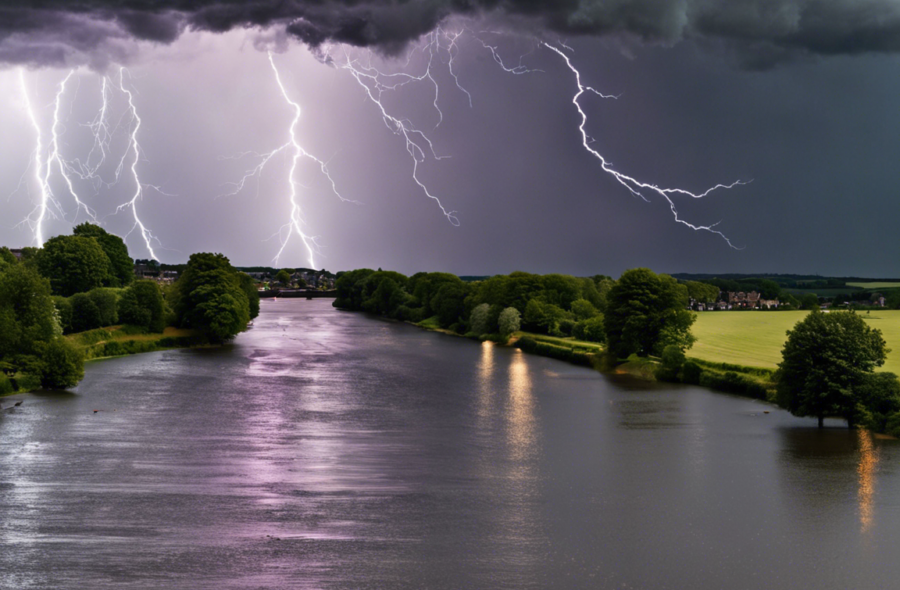Introduction
Thunderstorms are a common occurrence in the UK, particularly during the summer months when hot and humid conditions create the perfect environment for these intense weather events. The Met Office plays a vital role in monitoring and forecasting thunderstorms to help keep the public safe and prepared for any potential impacts.
Understanding Thunderstorms
Thunderstorms are characterized by the rapid growth of cumulonimbus clouds, which are often accompanied by heavy rain, strong winds, lightning, and sometimes hail. These powerful storms can develop rapidly and have the potential to cause widespread damage and disruptions to daily life.
Met Office Thunderstorm Warnings
The Met Office issues thunderstorm warnings to alert the public and authorities about the potential for severe weather conditions. These warnings are based on advanced weather modeling techniques and data from a network of weather stations and satellites, allowing forecasters to predict the movement and intensity of thunderstorms with a high degree of accuracy.
Types of Thunderstorm Warnings
-
Yellow Warning: This is the lowest level of warning and is issued when severe weather is possible, but not expected to be widespread. It serves as an advisory for the public to stay alert and be prepared for disruptions.
-
Amber Warning: This level of warning is issued when severe weather is expected and could potentially cause significant impacts, such as flash flooding, strong winds, and lightning strikes. The public is advised to take precautionary measures and stay informed about changing weather conditions.
-
Red Warning: The highest level of warning, a red warning is issued when extreme weather conditions are imminent and pose a significant risk to life and property. The public is urged to take immediate action to ensure their safety and follow the advice of emergency services.
Impact of Thunderstorms
Thunderstorms can have a range of impacts, including:
- Flooding: Heavy rainfall from thunderstorms can lead to flash floods, causing damage to homes, roads, and infrastructure.
- Lightning Strikes: Lightning is a major safety concern during thunderstorms, as it can pose a risk of electrocution and start fires.
- Strong Winds: Gusts of wind accompanying thunderstorms can cause damage to buildings, trees, and power lines.
- Hail: Large hailstones can cause damage to vehicles, crops, and property.
Staying Safe During Thunderstorms
To stay safe during thunderstorms, it is important to:
- Stay Indoors: Avoid going outside during thunderstorms to reduce the risk of being struck by lightning.
- Seek Shelter: If you are caught outside, seek shelter in a sturdy building or a hard-topped vehicle.
- Avoid Water: Do not swim or take a bath during thunderstorms, as water conducts electricity.
- Unplug Electronic Devices: To prevent damage from power surges, unplug electronic devices during thunderstorms.
- Follow Safety Guidelines: Stay informed about weather warnings and follow the advice of the Met Office and emergency services.
FAQs
-
What causes thunderstorms to form?
Thunderstorms form when warm, moist air rises rapidly in the atmosphere, leading to the development of cumulonimbus clouds and the subsequent release of energy in the form of thunder and lightning. -
How accurate are Met Office thunderstorm warnings?
Met Office thunderstorm warnings are highly accurate due to advanced weather modeling techniques and real-time data collection. However, weather can be unpredictable, so it is important to stay updated on the latest forecasts. -
What should I do if a thunderstorm warning is issued in my area?
If a thunderstorm warning is issued, stay indoors, away from windows, and avoid using electrical appliances. Follow the advice of the Met Office and emergency services to ensure your safety. -
Can thunderstorms cause power outages?
Yes, thunderstorms can cause power outages by damaging power lines and electrical infrastructure. It is advisable to unplug electronic devices during thunderstorms to prevent damage from power surges. -
Are thunderstorms more common in certain regions of the UK?
Thunderstorms can occur across the UK, but they are more prevalent in southern and eastern regions during the summer months when warm, moist air masses are more likely to interact and create unstable atmospheric conditions.
In conclusion, thunderstorms are a natural phenomenon that can have significant impacts on our daily lives. By staying informed about thunderstorm warnings and taking necessary precautions, we can minimize the risks associated with these powerful weather events. The Met Office’s role in forecasting and monitoring thunderstorms is vital in helping ensure public safety and preparedness.

